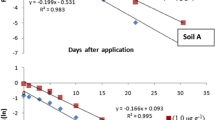Abstract
Persistence of flubendiamide in soil as affected by UV and sunlight exposure and in water as affected by pH was studied. At field capacity moisture regime, soil was treated with flubendiamide and exposed to UV and sunlight. Dissipation for the pesticide followed mono-phasic first order kinetics. Residues of flubendiamide, as thin film on petri-plates and soil thin film, dissipated with half-lives of 7.0 and 9.1 days under UV light and 12.0 and 19.1 days under sunlight, respectively. Residues of flubendiamide dissipated faster under UV light as compared to sunlight. Persistence study in aqueous medium under different pH condition indicated that flubendiamide residues persisted in water beyond 250 days with half-lives ranging from 250.8 to 301.0 days. Dissipation in water was faster at pH 4.0 (T1/2 250.8 days), followed by pH 9.2 (T1/2 273.6 days) and 7.0 (T1/2 301.0 days).



Similar content being viewed by others
References
Black CA (1965) Method of soil analysis (parts 1 and 2). American Society of Agronomy, Madison, WI
Fernandez MD, Perez RA, Sanchez-Brunete C, Tadeo JL (2001) Persistence of simazine and hexazinone in soil. Fresenius Environ Bull 10:490–494
Ganier CP, Breuzin C, Portal JM, Schiavon M (1996) Availability and persistence of isoproturon under field and laboratory conditions. Ecotoxicol Environ Safety 35:226–230
Jackson ML (1967) Soil chemical analysis. Prentice Hall, New Delhi, India
Katagi T (2004) Photodegradation of pesticides on plant and soil surfaces. Rev Environ Contam Toxicol 182:1–189
Klopffer W (1992) Photochemical degradation of pesticides and other chemicals in the environment: a critical assessment of the state of the art. Sci Total Environ 123(124):145–159
Konstantinou IK, Zarkadis AK, Albanis TA (2001) Photodegradation of selected herbicides in various natural waters and soils under environmental conditions. J Environ Qual 30:121–130
Miller GC, Zepp RG (1983) Extrapolating photolysis rates from the laboratory to the environment. Residue Rev 85:89–110
Sanyal D, Yaduraju NT, Kulshrestha G (2000) Metolachlor persistence in laboratory and field soils under Indian tropical conditions. J Environ Sci Health B 35:571–583
Scheunert I (1992) Physical and physicochemical processes governing the residue behaviour of pesticides in terrestrial ecosystems. In: Ebing W (ed) Chemistry of plant protection, vol. 8. Springer-Verlag, Berlin, pp 1–12
Shane H (2006) Flubendiamide: the next generation in lepidoptera pest management. Paper presented at the annual meeting of the Entomological Society of America (ESA) held at research Triangle Park, NC, December 10–13
Author information
Authors and Affiliations
Corresponding author
Rights and permissions
About this article
Cite this article
Das, S.K., Mukherjee, I. Effect of Light and pH on Persistence of Flubendiamide. Bull Environ Contam Toxicol 87, 292–296 (2011). https://doi.org/10.1007/s00128-011-0333-9
Received:
Accepted:
Published:
Issue Date:
DOI: https://doi.org/10.1007/s00128-011-0333-9




